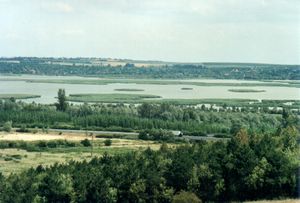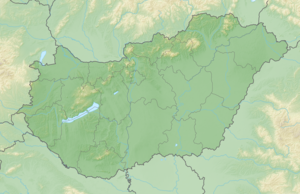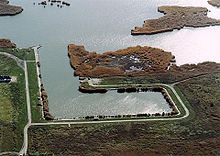Lake Velence
| Lake Velence | ||
|---|---|---|

|
||
| Lake Velence | ||
| Geographical location | Hungary | |
| Tributaries | Császár-víz | |
| Drain | (no drain) | |
| Places on the shore | Gárdony | |
| Data | ||
| Coordinates | 47 ° 13 ' N , 18 ° 37' E | |
|
|
||
| Altitude above sea level | 100 m | |
| surface | 24.9 km² | |
| length | 10.8 km | |
| width | 3.5 km | |
| volume | 39,840,000 m³ | |
| Maximum depth | 3 m | |
| Middle deep | 1.6 m | |
|
particularities |
warmest lake in Europe |
|
Lake Velence ( Hungarian : Velencei-tó , German: Welenzer See ) is the third largest natural lake in Hungary .
location
The lake is located at 103 m , about halfway between Lake Balaton and the capital Budapest, 40 kilometers away, in Fejér County . The lake is 10.8 kilometers long, between 1.5 and 3.5 kilometers wide, and covers an area of 24.9 square kilometers. Its environment resembles the Velence Mountains and its 352 meter high Meleg-hegy (German: Warmer Berg) in the north, and flatter shores in the south, the Balaton, because Lake Velence lies in the continuation of its tectonic rift.
The sea
With an average depth of only 1.60 meters, Lake Velence is shallow. The deepest point is just over three meters. Apart from smaller tributaries, as a steppe lake, it is particularly dependent on rain as a water supply. However, this usually does not happen because of the northern mountain range, as the warm air masses rising here keep the moist air layers away. In a cycle of around 150 years, the lake is almost dry. In 1843, hussars carried out a whole maneuver in the dry lake bed. In 1993 the water withdrew up to 50 meters from the bank. Water was artificially pumped in at high costs, but only a winter rainy season filled the lake up to its current level. About a third of the entire lake surface is crossed by reeds. A bird sanctuary that is only accessible with a special permit extends over a large area in the heavily reed-up north-west. On the northeastern bank near the village of Velence there is a 2300 meter long and 140 meter wide regatta course for canoeing and rowing competitions.
The lake is considered to be the warmest in Europe, as the water warms up to temperatures of 26 to 28 ° C in the summer months. The south, east and north-east banks offer many swimming opportunities. The tourist centers are Velence , Gárdony and Agárd . The lake has the peninsula Szúnyogsziget (= mosquito island) with an arboretum on the north bank between Pákozd and Sukoró .
history
The name Velence did not appear until the 15th century. According to the Italian Antonio Bonfini , a historian of King Mathias , his name goes back to residents of the Veneto who settled here (the Hungarian name for Venice is Velence ). Before that it was called Fertő, which means something like swamp or pond.
On September 29, 1848, north of the lake, near Pákozd, the first and victorious battle of the Hungarian struggle for freedom against the Habsburgs was fought . A memorial plaque in the church of Sukoró reminds of this today. On the eve of this battle, the first Hungarian Prime Minister, Count Lajos Batthyány, gave an important speech here. On an elevation on the north bank, a simple obelisk commemorates the scene of the battle.
The lake was developed as a recreation area in the 1930s. Two thermal baths have been opened in recent years. A bath between Gárdony and Agárd, which has existed at a natural thermal water source since 1984, was expanded and modernized in 2007. In Velence at the end of November 2008, a completely new pool with an attached hotel was built directly on the south-eastern lake shore. There are two islands that were heaped up during dredging work in the 1960s. In addition, the shoreline at the seaside resorts was largely concreted.
Worth seeing
- In the north of the lake is the village of Pákozd with one of the most important Bronze Age settlements in Hungary.
- A museum is located near the obelisk on a hill on the north bank.
- The press house of the poet Mihály Vörösmarty is on Bence Hill on the north bank, his memorial museum is in Kápolnásnyék.
- The house in which the writer Géza Gárdonyi was born and now the museum is in Agárd. The author of the novel Sterne von Eger , from whose school reading most Hungarian children get to know the Turkish era, was born as a Ziegler , so was a Hungarian German.
gallery
Web links
- Velencei tó in A Pallas nagy lexikona (Hungarian)
- Aerial views of the lake





